
Totteridge is a residential area and former village in the London Borough of Barnet, England. It is a mixture of suburban development and open land situated 8 miles (13 km) north north-west of Charing Cross. It is part of the Whetstone postal district (N20).
The Worshipful Company of Wax Chandlers is one of the oldest livery companies of the City of London, with one of the smallest memberships.
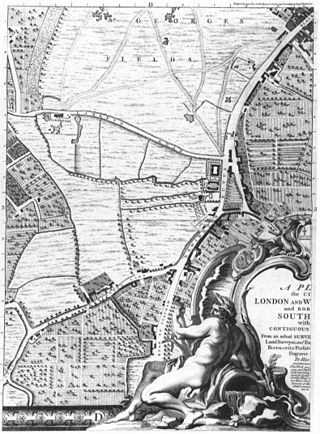
St George's Fields was an area of Southwark in south London, England.

St Andrew-by-the-Wardrobe is a Church of England church located on Queen Victoria Street, London in the City of London, near Blackfriars station.

St Andrew Undershaft is a Church of England church in the City of London, the historic nucleus and modern financial centre of London. It is located on St Mary Axe, within the Aldgate ward, and is a rare example of a City church that survived both the Great Fire of London and the Blitz.

Coade stone or Lithodipyra or Lithodipra is stoneware that was often described as an artificial stone in the late 18th and early 19th centuries. It was used for moulding neoclassical statues, architectural decorations and garden ornaments of the highest quality that remain virtually weatherproof today.

Restalrig is a small residential suburb of Edinburgh, Scotland. It is located east of the city centre, west of Craigentinny and to the east of Lochend, both of which it overlaps. Restalrig Road is the main route through the area, running from London Road, at Jock's Lodge, to Leith Links. It is in the ward of Lochend.

St Olave's Church, Old Jewry, sometimes known as Upwell Old Jewry, was a church in the City of London located between the street called Old Jewry and Ironmonger Lane. Destroyed in the Great Fire of London in 1666, the church was rebuilt by the office of Sir Christopher Wren. The church was demolished in 1887, except for the tower and west wall, which remain today.

St Michael Paternoster Royal is a church in the City of London. The original building, which was first recorded in the 13th century, was destroyed in the Great Fire of London in 1666. The church was rebuilt under the aegis of Sir Christopher Wren. However St Michael's was severely damaged during the London Blitz in the Second World War. It was restored between 1966 and 1968.

Alfred Charles William Harmsworth, 1st Viscount Northcliffe, was a British newspaper and publishing magnate. As owner of the Daily Mail and the Daily Mirror, he was an early developer of popular journalism, and he exercised vast influence over British popular opinion during the Edwardian era. Lord Beaverbrook said he was "the greatest figure who ever strode down Fleet Street." About the beginning of the 20th century there were increasing attempts to develop popular journalism intended for the working class and tending to emphasize sensational topics. Harmsworth was the main innovator. He said, "News is something someone wants to suppress. Everything else is advertising."

St Michael Bassishaw, or Basinshaw, was a parish church in Basinghall Street in the City of London, standing on land now occupied by the Barbican Centre complex. Recorded since the 12th century, the church was destroyed in the Great Fire of 1666, then rebuilt by the office of Sir Christopher Wren. The rebuilt church was demolished in 1900.

Holy Trinity Gough Square was a Victorian church in the City of London.
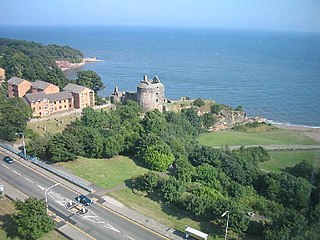
Ravenscraig Castle is a ruined castle located in Kirkcaldy which dates from around 1460. The castle is an early example of artillery defence in Scotland.

Esher Place is a Grade-II listed country house, since 1953 used as a college by the trade union Unite, in Esher, Surrey, United Kingdom. The building is at least the fourth on approximately the same site and mainly dates to the 1890s. It incorporates traces and small parts of some its earlier forebears.
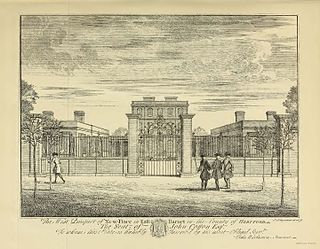
Little Grove, originally Danegrove, was a house and estate that once existed in East Barnet on high ground to the south of Cat Hill. The original house on the site dated from at least the mid sixteenth century. In 1719, it was demolished and replaced with a house known as New Place but the house soon returned to the name of Little Grove. That house was demolished in 1932 to make way for a housing development and primary school known as Littlegrove.

St Andrew's is the Church of England church for Totteridge in north London. It is located in the Diocese of St Albans, one of the few churches in Greater London to have this distinction.
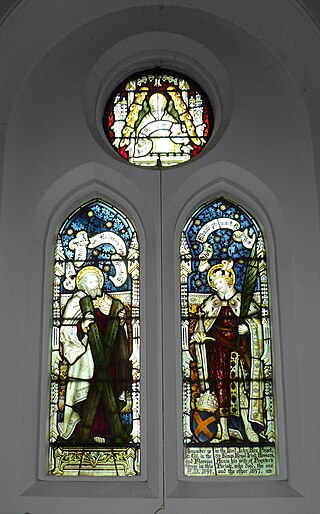
John Hey Puget (1829–1894) was a colonel in the 8th King's Royal Irish Hussars. He was a fellow of the Royal Geographical Society.
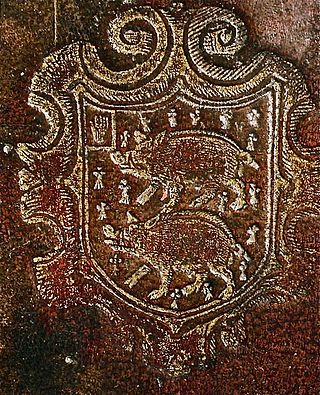
Sir Paul Whichcote, 2nd Baronet (1643–1721), was a fellow of the Royal Society and the owner of the Manor of Totteridge in Hertfordshire.
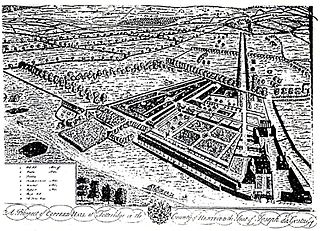
The Manor of Copped Hall was located to the south of St Andrew's church in Totteridge, Hertfordshire, in an area that is now part of the London Borough of Barnet.
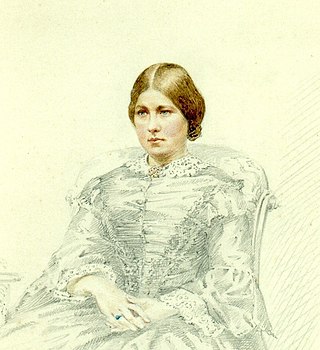
Geraldine Mary Harmsworth was an Irish matriarch.



















